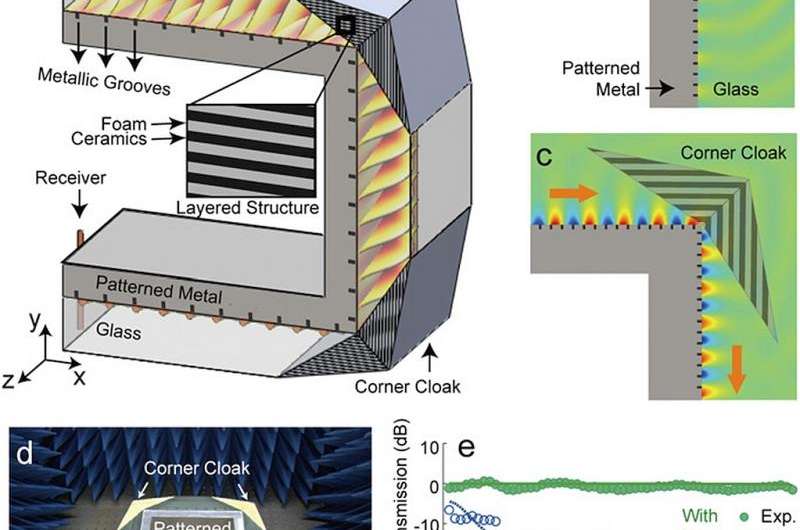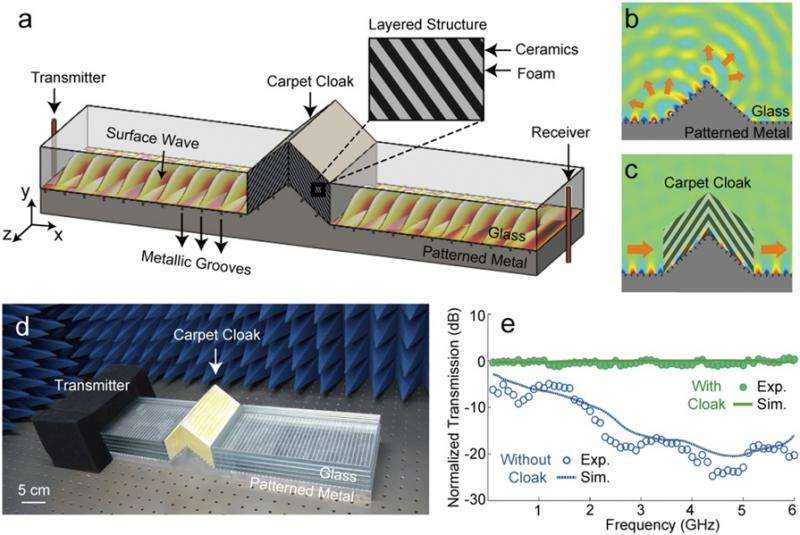July 13, 2015 feature
Clever cloaks: Unique metamaterials preserve phase while guiding surface waves around ultrasharp corners and bumps

(Phys.org)—Today's photonic and plasmonic devices – the latter based on surface plasmons (a coherent delocalized electron oscillations that exist at the interface between metal and dielectric) and combining the small size and manufacturability of electronics with the high speeds of optics – need the ability to guide surface electromagnetic waves around disorder, such as ultrasharp corners and bumps, without disturbing the wave amplitude or phase. That being said, achieving this preservation of phase and amplitude has been difficult due to the fact that light momentum must be conserved in a scattering event (that is, when electromagnetic radiation or particles are deflected or diffused by localized non-uniformities in the medium through which that radiation is passing). However, scientists at Zhejiang University in Hangzhou, China, Nanyang Technological University, Singapore, and Massachusetts Institute of Technology created (so-called invisibility) cloaks based on specifically-designed nonmagnetic anisotropic, or directionally dependent, metamaterials that achieve nearly ideal transmission efficiency over a broadband frequency range. The researchers state that results the viability of applying transformation optics – which applies metamaterials to produce spatial variations, derived from coordinate transformations, which can direct chosen bandwidths of electromagnetic radiation – to plasmonic circuits, and in so doing could lead to high-performance, large-scale integrated photonic circuits.
Prof. Hongsheng Chen at Zhejiang University and Prof. Baile Zhang at Nanyang Technological University discussed the paper that they and their colleagues published in Proceedings of the National Academy of Sciences. "In overcoming narrow-band light transmission limitations and disorder-related phase disturbances in guiding surface electromagnetic waves, the fundamental challenge lies in realizing broadband scattering-free propagation – that is, how to match momentum when the surface wave propagates before or after the disorder in a broad band," Chen tells Phys.org. In other words, surface waves suffer from scattering loss as a result of momentum mismatch when encountering sharp corners or other irregular disorders.
A related obstacle was demonstrating – both theoretically and experimentally – broadband surface electromagnetic wave guidance around ultrasharp corners and bumps with no perceptible changes in amplitude and phase. "Theoretically, transformation optics can potentially provide a solution to guide the surface wave by warping the electromagnetic space around ultrasharp corners, so that electromagnetic surface waves will be deceived as if they were still propagating along a flat surface without any corner," Chen explains. However, he adds, since this generally requires both electric and magnetic anisotropic materials and is therefore difficult to implement, the main theoretical challenge in cloaking disorders is to design a feasible coordinate transformation with anisotropic parameters. "Experimentally," Chen continues, "the main challenge is designing and implementing a feasible non-magnetic metamaterial that meets the parameter requirements derived from transformation optics, because a stable magnetic response is difficult to realize over a broad frequency band."
A third fundamental issue facing the researchers was the design of inhomogeneous metamaterials that control light. "Realizing a continuous inhomogeneous metamaterial is very difficult in practice," Chen points out. "Generally, we can use artificial metamaterial units with different subwavelength geometries, similar to the atoms in natural media, to realize inhomogeneous electromagnetic parameters – but this requires very fine nanofabrication procedures."

Zhang lists the three key insights and innovations the researchers used to address these challenges:
● Overcoming the challenge of momentum mismatch by adopting strict transformation optics with anisotropy in the design – a strategy that can also work for ultrasharp corners and bumps
● Realizing broadband performance by employing an area-preserving coordinate transformation, which can produce non-magnetic constitutive parameters for a surface plasmon polariton (SPP –an electromagnetic excitation existing on the surface of an appropriate metal) wave cloak
● Experimentally demonstrating SPP cloak performance by designing a layered metamaterial composed of microwave ceramic plates and low-permittivity foam with subwavelength periodicity (in which the periodicity of the metamaterial is much smaller than the wavelength of the electromagnetic wave being cloaked)
In terms of likely applications of transformation optics in plasmonic circuits and high-performance, large-scale integrated photonic circuits, Zhang points out that over the last few decades, surface plasmons have attracted substantial research effort because they offer the potential for merging electronics and photonics on the same chips by reducing the size of photonic components to the nanoscale. "Therefore, plasmonics is a key technology for interconnects – but guiding light around sharp bends is one of the main limiting factors for plasmonics." (The other limiting factor is loss, which also occurs in straight waveguides.) "In this study we made plasmonic technology the main motivation and tried to solve the scattering issue during wave propagation across disorder. In short, our research focuses on scattering-free guiding."
The paper also mentions other applications resulting from switching from free-space electromagnetic waves to surface electromagnetic waves. "Free-space electromagnetic invisibility cloaks and other free-space devices based on transformation optics have the property of superluminal propagation," Zhang explains. "This will fundamentally introduce narrowband." (Narrowband refers to signals over a narrow range of frequencies.) "However, if we can transition from free-space waves to surface waves, we can take slow waves into consideration and achieve broad bandwidth." As a result, scattering-free surface plasmon polariton wave guidance can be used in a wide range of applications, such as plasmonic phase modulators (which slows plasmons, leading to what is essentially an optical switch) and beam steering changing the direction of an electromagnetic signal).
![Fig. 3. A Gaussian-shaped pulse propagates on the patterned metal. A point source (port 1) generates the pulse at 0 ns. The bandwidth of the pulse is 6 GHz, and the center frequency is 3 GHz. The magnetic field distributions for three cases [(A) the corner cloaks, (B) the carpet cloak, and (C) the straight waveguide reference] are plotted to show the propagation of the pulse at five equivalent temporal sampling points. Credit: Xu S, et al. (2015) Broadband surface-wave transformation cloak. Proc Natl Acad Sci USA 112(25):7635-7638. A Gaussian-shaped pulse propagates on the patterned metal](https://scx1.b-cdn.net/csz/news/800a/2015/agaussiansha.jpg)
The paper also discusses the interesting point that transformation optics effectively warps electromagnetic space in a manner analogous to how gravity curves space in general relativity. "The macroscopic performance of warping electromagnetic space can be expressed by constitutive parameters in a new coordinate system." (Constitutive parameters describe the desired or actual performance and responses of a metamaterial.) Specifically, Zhang notes, these new constitutive parameters can be isotropic, anisotropic, or bianisotropic (that is, identical in all directions, directionally dependent, and asymmetrically anisotropic, respectively), and might be realized by metamaterial design and fabrication. "With this procedure," he emphasizes, "we'd have the ability to operate and control electromagnetic waves in exactly the way we want."
Another important point in the paper was overcoming the issue with previous cloaks requiring that the phase velocity of light being guided around the cloaked object had to exceed the vacuum speed of light. "Cloaking from free-space electromagnetic waves suffers from narrow bandwidth because the phase velocity," which depends on both frequency and medium, "is required to be greater than the speed of light. In our work, given that the surface wave propagates much more slowly than the speed of light, we can avoid superluminal propagation in free space cloaking."
Finally, the key result being reported is that unlike topological electromagnetic surface states, in the new approach phase is preserved when surface waves are perfectly guided by the cloaks. "Sharp bending of surface waves was previously achieved only in topological electromagnetic edge states," Zhang tells Phys.org. "Because the required materials generally are magnetic, it suffers from narrow bandwidth. In our work, however, the use of anisotropic non-magnetic materials and transformation optics ensure the phase preservation of surface waves."
Chen says that the scientists plan to extend their experimental demonstration from microwaves to higher frequencies, including infrared and visible light. "This may push our work much closer to practical application. Moreover, scientists have extended the concept of transformation beyond electromagnetic fields to other types of physical fields, such as heat, diffusive light, acoustics, and static fields. "No matter which kind of physical field it is, the fundamental point is to control the propagation of the waves and the distribution of the field," Chen concludes. "Our work can therefore be extended to many other areas of research."
More information: Broadband surface-wave transformation cloak, Proceedings of the National Academy of Sciences (2015) 112(25):7635-7638, doi:10.1073/pnas.1508777112
Journal information: Proceedings of the National Academy of Sciences
© 2015 Phys.org


















